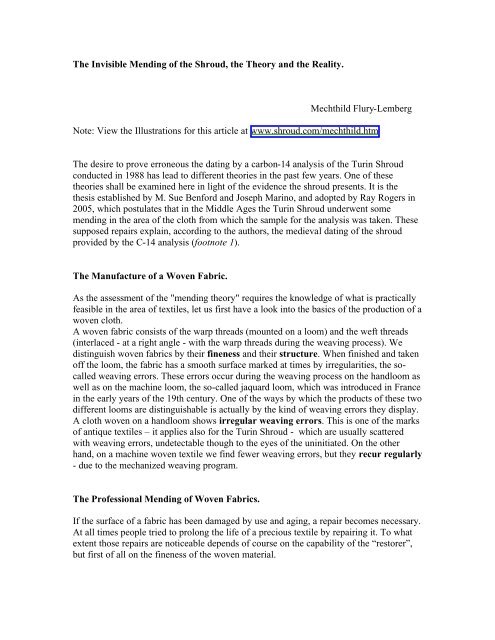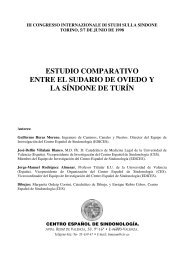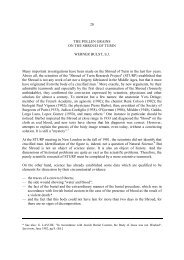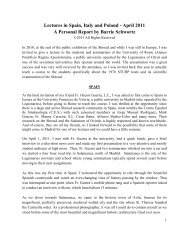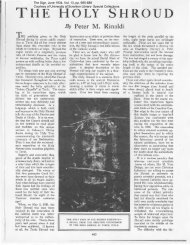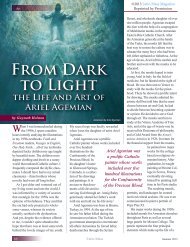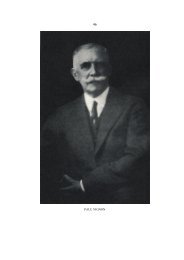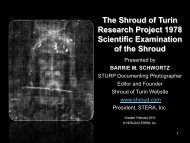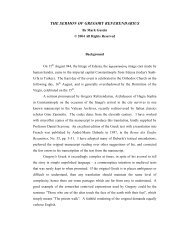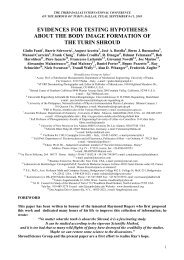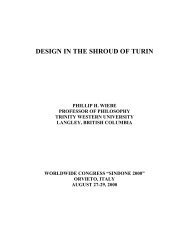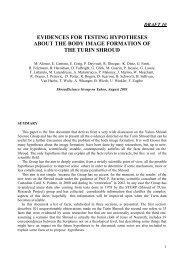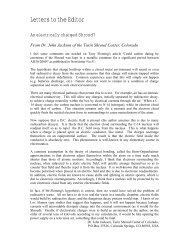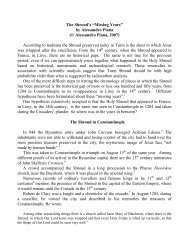BSTS Newsletter No. 65 - Part 5 - The Shroud of Turin Website
BSTS Newsletter No. 65 - Part 5 - The Shroud of Turin Website
BSTS Newsletter No. 65 - Part 5 - The Shroud of Turin Website
You also want an ePaper? Increase the reach of your titles
YUMPU automatically turns print PDFs into web optimized ePapers that Google loves.
<strong>The</strong> Invisible Mending <strong>of</strong> the <strong>Shroud</strong>, the <strong>The</strong>ory and the Reality.<br />
Mechthild Flury-Lemberg<br />
<strong>No</strong>te: View the Illustrations for this article at www.shroud.com/mechthild.htm<br />
<strong>The</strong> desire to prove erroneous the dating by a carbon-14 analysis <strong>of</strong> the <strong>Turin</strong> <strong>Shroud</strong><br />
conducted in 1988 has lead to different theories in the past few years. One <strong>of</strong> these<br />
theories shall be examined here in light <strong>of</strong> the evidence the shroud presents. It is the<br />
thesis established by M. Sue Benford and Joseph Marino, and adopted by Ray Rogers in<br />
2005, which postulates that in the Middle Ages the <strong>Turin</strong> <strong>Shroud</strong> underwent some<br />
mending in the area <strong>of</strong> the cloth from which the sample for the analysis was taken. <strong>The</strong>se<br />
supposed repairs explain, according to the authors, the medieval dating <strong>of</strong> the shroud<br />
provided by the C-14 analysis (footnote 1).<br />
<strong>The</strong> Manufacture <strong>of</strong> a Woven Fabric.<br />
As the assessment <strong>of</strong> the "mending theory" requires the knowledge <strong>of</strong> what is practically<br />
feasible in the area <strong>of</strong> textiles, let us first have a look into the basics <strong>of</strong> the production <strong>of</strong> a<br />
woven cloth.<br />
A woven fabric consists <strong>of</strong> the warp threads (mounted on a loom) and the weft threads<br />
(interlaced - at a right angle - with the warp threads during the weaving process). We<br />
distinguish woven fabrics by their fineness and their structure. When finished and taken<br />
<strong>of</strong>f the loom, the fabric has a smooth surface marked at times by irregularities, the socalled<br />
weaving errors. <strong>The</strong>se errors occur during the weaving process on the handloom as<br />
well as on the machine loom, the so-called jaquard loom, which was introduced in France<br />
in the early years <strong>of</strong> the 19th century. One <strong>of</strong> the ways by which the products <strong>of</strong> these two<br />
different looms are distinguishable is actually by the kind <strong>of</strong> weaving errors they display.<br />
A cloth woven on a handloom shows irregular weaving errors. This is one <strong>of</strong> the marks<br />
<strong>of</strong> antique textiles – it applies also for the <strong>Turin</strong> <strong>Shroud</strong> - which are usually scattered<br />
with weaving errors, undetectable though to the eyes <strong>of</strong> the uninitiated. On the other<br />
hand, on a machine woven textile we find fewer weaving errors, but they recur regularly<br />
- due to the mechanized weaving program.<br />
<strong>The</strong> Pr<strong>of</strong>essional Mending <strong>of</strong> Woven Fabrics.<br />
If the surface <strong>of</strong> a fabric has been damaged by use and aging, a repair becomes necessary.<br />
At all times people tried to prolong the life <strong>of</strong> a precious textile by repairing it. To what<br />
extent those repairs are noticeable depends <strong>of</strong> course on the capability <strong>of</strong> the “restorer”,<br />
but first <strong>of</strong> all on the fineness <strong>of</strong> the woven material.
For example, whether dealing with a woven tapestry or with a linen cloth, the “restorers”<br />
<strong>of</strong> all ages face completely different problems when these textiles require mending.<br />
<strong>The</strong> way, how to close a hole <strong>of</strong> 1 square centimetre in a thick tapestry is described in the<br />
following (footnote 3).<br />
Example 1: coarse fabric in tapestry technique, wool,<br />
6 warp threads per 1 centimetre, 25 weft threads per 1 centimetre.<br />
First the missing warp threads are replaced by inserting new ones into the old material,<br />
fig.1, and then woollen threads matching the originals as closely as possible are darned in<br />
as weft threads according to the coarse structure <strong>of</strong> the fabric, fig.2.<br />
<strong>The</strong> new warp threads must be secured at the edges <strong>of</strong> the hole - which should show as<br />
little as possible on the front <strong>of</strong> the fabric. <strong>The</strong> ends <strong>of</strong> these threads either form slight<br />
ridges over a stretch <strong>of</strong> about 1 centimetre around the hole on the front, fig.2, or lie open<br />
on the back <strong>of</strong> the fabric, around the edges <strong>of</strong> the hole. <strong>The</strong>n the weft threads are<br />
interlaced. With some skill it is possible to hide the ends <strong>of</strong> these threads, and the darned<br />
area is <strong>of</strong>ten recognizable only by the different quality <strong>of</strong> the new weft threads in<br />
comparison with the originals. <strong>The</strong> coarse weaving structure <strong>of</strong> the tapestry allows for<br />
such a hole to be closed in a way that the repair is unnoticeable on the front <strong>of</strong> the fabric -<br />
no magic is involved here, fig 3 and 4.<br />
If the colour and the quality <strong>of</strong> the new weft threads are a perfect match for the original<br />
weft threads the operation is indeed invisible on the front, still it is always clearly<br />
recognizable on the back by the newly inserted warp threads.<br />
If the warp threads have been preserved in a damaged area (which makes the insertion <strong>of</strong><br />
new warp threads unnecessary), the operation is invisible on both sides <strong>of</strong> the textile and<br />
one can rightly call it "invisible inweaving" (footnote 3), fig.5 and 6.<br />
This kind <strong>of</strong> technical proceeding applicable exclusively to the coarse weaving structure<br />
<strong>of</strong> a tapestry, seems to be the basis <strong>of</strong> the argumentation <strong>of</strong> Benford/Marino (footnote 1).<br />
A completely different procedure is required for the repair <strong>of</strong> a delicate fabric. <strong>The</strong><br />
fineness <strong>of</strong> its threads and the resulting delicate, dense structure don't allow for the hiding<br />
<strong>of</strong> the added threads needed for repair.<br />
Example 2: Fine woven fabric in twill technique, linen,<br />
38 warp threads per 1 centimetre, 25 weft threads per 1 centimetre.<br />
<strong>The</strong>re is no method to make a hole <strong>of</strong> 1 square centimetre disappear in this type <strong>of</strong><br />
delicate fabric. It is <strong>of</strong> course feasible to restore the missing part, imitating exactly the<br />
weaving structure <strong>of</strong> the original, as has been described for the first example. This<br />
method is called today invisible mending, and threads from the original are used in the<br />
process. But even the most successful execution can ultimately not conceal the operation<br />
completely to the trained eye, and it will always be unequivocally visible on the reverse<br />
<strong>of</strong> the fabric.
Examples 1 and 2 are cases <strong>of</strong> inweaving. This is the most comprehensive method to<br />
restore a missing part in a weaving and it requires a specialist in this area, today as in the<br />
past.<br />
<strong>The</strong> Domestic Mending <strong>of</strong> a Woven Fabric.<br />
One <strong>of</strong> the very common repairs <strong>of</strong> a woven cloth is the closing <strong>of</strong> a hole by putting on a<br />
patch, as the sisters at Chambery have done. A patch usually covers a hole or an<br />
especially brittle, worn out area <strong>of</strong> a cloth. It is placed on top <strong>of</strong> the front, rising a little<br />
higher than the surrounding area, and by this alone is easily recognizable. If the patch is<br />
added to the reverse <strong>of</strong> a fabric, the brittle parts are fixed onto it. This too is very<br />
noticeable. Even though the Chambery patches had been attached with great care, there is<br />
no way to call the results invisible. Another domestic way to close a hole has always been<br />
to simply darn it with no regard to the structure <strong>of</strong> the fabric. Certainly this does not fall<br />
into the category <strong>of</strong> "invisible" (as in invisible mending).<br />
A fabric can also undergo other damages which do not result in a hole. Among these are<br />
damages caused by frequent handling or by abrasion <strong>of</strong> the fibres, or something else <strong>of</strong><br />
the sort. <strong>The</strong> result would be a worn out, brittle, threadbare textile, fig.9. Such a<br />
weakened fabric can be supported by fixing it onto another piece <strong>of</strong> material, as already<br />
mentioned above. <strong>The</strong> other possibility <strong>of</strong> consolidation is by darning, using new yarns,<br />
as one does with a worn sock, fig 9 and 10. <strong>The</strong>se methods used in normal daily life have<br />
always been and still are executed at very diverse levels <strong>of</strong> quality.<br />
One thing though that all efforts have in common: no matter how carefully the work is<br />
done, the operation always stays documented as such, it is never done in an invisible<br />
way.<br />
What then does “invisible mending” mean <strong>The</strong> phrase has <strong>of</strong> course been created as a<br />
promise to the costumer. It tells him: the damaged article will be restored so perfectly that<br />
nothing will be seen <strong>of</strong> the former damage, and so it has been in most cases. <strong>The</strong><br />
costumer, usually not an expert in the matter, can only be amazed by the artistry <strong>of</strong> the<br />
specialist who has been able to make the hole disappear. This means however: disappear<br />
as much as possible, which was satisfactory in many cases. By just looking at a tapestry,<br />
a garment or a tablecloth the layperson will never be able to discern easily a well mended<br />
hole. It does, however, not mean that the operation has to go undetected by the expert. To<br />
such a person mending will <strong>of</strong> course always be noticeable to the naked eye. As these<br />
repairs have been executed with the naked eye, they can also be recognized without a<br />
magnifying glass by the trained eye!<br />
<strong>The</strong> Mending <strong>of</strong> the <strong>Shroud</strong>.<br />
<strong>The</strong> <strong>Shroud</strong> <strong>of</strong> <strong>Turin</strong> is a woven linen cloth <strong>of</strong> the structure described above in example 2.<br />
<strong>The</strong> cloth - in its entirety exceptionally well preserved - has, in the course <strong>of</strong> its history,<br />
suffered some damage. After it was damaged in a fire the sisters <strong>of</strong> Chambery put the<br />
cloth on a support fabric and covered the burned holes very carefully with pieces <strong>of</strong>
fabric, in order to be able to show the relic without these disfiguring damages. <strong>The</strong><br />
support lining was first fixed to the shroud by basting stitches executed from the back.<br />
For the purpose <strong>of</strong> getting the desired support when connecting the two fabrics it was<br />
necessary to also prick the back <strong>of</strong> the shroud. This joining <strong>of</strong> the two fabrics was done<br />
with great care. Long stitches were used on the lining, the so-called Dutch cloth, fig.13,<br />
very small stitches seized only the back <strong>of</strong> the shroud, fig.14, leaving on its front only the<br />
marks <strong>of</strong> tiny stitches or slight depressions (footnote 2). Later in time, as the continued<br />
handling <strong>of</strong> the shroud caused small damages to the patched areas, these were darned<br />
coarsely with brown yarn, matching the colour that showed under the damaged patches.<br />
<strong>The</strong>se repairs were the only historical stitching done on the shroud - apart from the one<br />
vertical seam and the small rolled hems at the edges <strong>of</strong> the width.<br />
This is all that ever needed to be done - leaving out, for now, the two cut away corners.<br />
<strong>The</strong> <strong>The</strong>ory and the Reality <strong>of</strong> the Invisible Medieval Mending <strong>of</strong> the <strong>Shroud</strong>.<br />
<strong>The</strong> theory that repairs had been done to the corner areas in the Middle Ages,<br />
unfortunately is based on a false presupposition. <strong>The</strong> necessity <strong>of</strong> repairs to the corners<br />
has been postulated without ever examining the need for it. <strong>The</strong> real reason for the theory<br />
has been the desire to find a plausible explanation for the unsatisfying result <strong>of</strong> the<br />
carbon-14 analysis. Similar wishes, although understandable, have lead all too <strong>of</strong>ten in<br />
the history <strong>of</strong> the shroud to untenable theories. <strong>The</strong> starting point for every scientific<br />
study <strong>of</strong> the cloth, however, has to be the reality <strong>of</strong> the linen material itself including the<br />
equally very real traces <strong>of</strong> the history left on the cloth. <strong>No</strong>r more, nor less. Even then<br />
enough room is left for misinterpretations; it is far from being scholarly research if the<br />
shroud is being used as pro<strong>of</strong> for wishful thinking.<br />
<strong>The</strong> linen shroud has never been buried in the ground. Its exceptionally good condition is<br />
in no way comparable to other shrouds which have spent hundreds <strong>of</strong> years in graves.<br />
Though the <strong>Turin</strong> shroud is burdened with the dust <strong>of</strong> centuries and with greasy dirt<br />
deposits on the corners, fig.15 - a result <strong>of</strong> the countless handlings in the past - its<br />
weaving structure is cohesive and untouched even at the corners. <strong>The</strong>refore at no time<br />
has the need to reinforce the corner parts arisen! If even the corner pieces cut away<br />
before the fire <strong>of</strong> Chambery, have not been replaced, why should remaining areas, dirty<br />
but intact, be reinforced or mended <strong>The</strong> completion <strong>of</strong> the corner areas was only<br />
achieved by the conservation measures <strong>of</strong> Chambery, when the whole shroud had to be<br />
provided with a lining (the so-called Dutch cloth) to secure its stability. <strong>The</strong> chosen<br />
colour <strong>of</strong> the supportive lining also solved the problem <strong>of</strong> the missing corners by closing<br />
the gaps at least in an optical way. <strong>The</strong>se corners appeared complete again, and the others<br />
received more support than a repair could have provided.<br />
<strong>The</strong> late Raymond Rogers examined the surrounding areas where the sample had been<br />
taken, by means <strong>of</strong> infrared pictures <strong>of</strong> the shroud. <strong>The</strong> pictures show discolorations in<br />
these areas. This has been the inducement for the hypothesis <strong>of</strong> the mending in medieval<br />
times.
<strong>The</strong> infrared pictures show a diffuse discoloration at the corner in question, i.e. a<br />
discoloration without the definite outlines <strong>of</strong> an allegedly mended area. A darn would<br />
have to appear in the picture as clearly defined. <strong>The</strong> UV-fluorescent picture <strong>of</strong> a<br />
comparable woven material containing darns allows for the repairs to be recognized by<br />
the route <strong>of</strong> the threads used, fig.8! Furthermore the discoloured spot in the infrared<br />
picture is so big that it could not possibly be the location <strong>of</strong> a darn which had not<br />
previously been detected by the naked eye.<br />
If looked at without a magnifying glass - an “unscientific” way according to Rogers - the<br />
area around the removed sample and the preserved corners display discolorations as big<br />
as human palms: blackish deposits under which the fibres appear to be sticking together.<br />
<strong>The</strong>se coatings - obvious to the naked eye - are clearly in contrast to the surface <strong>of</strong> the<br />
rest <strong>of</strong> the shroud, fig.15. But they do not have their origins in added yarns used in<br />
darning or inweaving, as has been postulated, they are simply greasy dirt. This is a<br />
plausible explanation in view <strong>of</strong> the fact that innumerable unwashed hands have handled<br />
the shroud whenever it was shown in the past.<br />
<strong>The</strong> rubbed <strong>of</strong>f shoulder areas <strong>of</strong> a medieval gilded head reliquary, fig.16, exemplify<br />
sufficiently to what changes in the appearance, depending on the material, frequent<br />
touching by hands can lead.<br />
Rogers attributed the colour change <strong>of</strong> the one area <strong>of</strong> the shroud to medieval repairs to<br />
which he was unable to give further indications. <strong>No</strong>where in his analysis <strong>of</strong> the colour<br />
picture can be found a reference to the very real dirt deposit which is very visible without<br />
technical devices. So it could be expected that the deposit also showed in some way in<br />
the infrared picture. <strong>The</strong> question to the chemist in this regard would be: how do sweat<br />
and oil etc. from human hands show in an infrared picture <strong>The</strong>se imponderables,<br />
together with the fine coal dust embedded in all the fibres <strong>of</strong> the cloth make the use <strong>of</strong> the<br />
carbon-14 analysis unsuitable in this case. <strong>The</strong> presence <strong>of</strong> the greasy dirt deposit at the<br />
"removal site" alone would be sufficient to demonstrate the uselessness <strong>of</strong> the carbon-14<br />
method, without having to construct an untenable "mending theory".<br />
Equally lacking any trace <strong>of</strong> evidence on the shroud is the hypothesis that a patch fixed<br />
onto the same minute spot which had been removed as a sample has falsified the result <strong>of</strong><br />
the analysis. Where exactly had the patch been attached How big was it Was it so small<br />
that it covered only the sample area Answers to these questions are lacking in the<br />
hypothesis <strong>of</strong> Benford/Marino and Rogers. <strong>The</strong>y can only be given in a competent way<br />
by textile experts. One <strong>of</strong> them, who was present when the sample was taken, the late<br />
Gabriel Vial, confirmed repeatedly that the sample was taken from the original cloth!<br />
This affirmation seems to be unacceptable to a natural scientist even if it comes from<br />
such an excellent textile scholar as Gabriel Vial who moreover made this judgment in his<br />
very own field <strong>of</strong> expertise.<br />
In any case, neither on the front nor on the back <strong>of</strong> the whole cloth is the slightest hint <strong>of</strong><br />
a mending operation, a patch or some kind <strong>of</strong> reinforcing darning, to be found, fig.17 and<br />
18.
Footnotes<br />
1) Joseph G. Marin,/ M. Sue Benford, Evidence for the Skewing<br />
<strong>of</strong> the C-14dating <strong>of</strong> the <strong>Shroud</strong> <strong>of</strong> <strong>Turin</strong> due to Repairs.<br />
M. Sue Benford, /Joseph G. Marino, New Evidence Explaining<br />
the “Invisible Patch” in the C-14 Sample Area <strong>of</strong> the <strong>Turin</strong> <strong>Shroud</strong>.<br />
Raymond N. Rogers, Studies on the radiocarbon sample from the<br />
shroud <strong>of</strong> turin.<br />
2) Mechthild Flury-Lemberg, Sindone 2000 /Preservation;<br />
Torino 2003 ODPF; p.67, Paragraph 24; Abb. 42a;<br />
3)Mechthild Flury-Lemberg, Textile Conservation and Research;<br />
Abegg-Stiftung Bern 1988; „Tapestries“: pp 75-98<br />
Translation : Brigitta Schmedding , Toronto<br />
Captions to the Illustrations.<br />
1.) Section from the edge <strong>of</strong> a tapestry. <strong>The</strong> warp threads have been replaced where they<br />
were missing. <strong>The</strong> new threads have been secured at the edge <strong>of</strong> the material in such a<br />
way that they now lie on top <strong>of</strong> the old remaining threads in the original material for<br />
about 1 cm (on the right in the picture).<br />
If the knotted ends <strong>of</strong> the threads lie on the face <strong>of</strong> the material they are cut and only a<br />
raised area around the former hole is visible, fig.2.<br />
If the ends <strong>of</strong> the threads are left on the back they usually are not cut away and as a result<br />
are visible there.<br />
2.) On the left the ends <strong>of</strong> the warp threads around the inweaving can be seen.<br />
3.) and 4.) On the left: a hole with broken warp threads before the repair.<br />
On the right: a perfectly done restoration which could be called “invisible”, but still the<br />
trained eye recognizes without effort where the ends <strong>of</strong> the newly inserted warp threads<br />
have been secured.
5.) and 6.) Detail <strong>of</strong> a late Medieval tapestry. <strong>The</strong> weft threads have disappeared, the<br />
warp threads have stayed in place.<br />
On the left: If the ends <strong>of</strong> the new weft threads did not appear on the reverse <strong>of</strong> the<br />
tapestry, we could call it an “invisible mending”. But, as has been stated already, even<br />
then is true: invisible does not necessarily mean unrecognizable by the expert.<br />
7.) and 8.) Same detail:front and back <strong>of</strong> damask napkin, Abegg Stiftung Bern Inv. <strong>No</strong><br />
3829 ; displaying the most delicately done darning, hardly visible on the front, but much<br />
more obvious on the back <strong>of</strong> the textile.<br />
9.) Banquet Napkin <strong>of</strong> Pope Urban VIII:, (1624 ) Headley Parish Church, Surrey.<br />
A very used, literally threadbare damask worthy <strong>of</strong> a repair. This condition represents the<br />
extreme contrast to the well preserved corner <strong>of</strong> the shroud shown in fig.16.<br />
10.) <strong>The</strong> UV-fluorescent picture <strong>of</strong> the damask shown in fig.9. <strong>The</strong> little white blotches<br />
indicate the repaired spots. In them the route taken by the darning threads can be<br />
followed.<br />
11.) and 12.) Shown here is a darned area executed (by Irene Tomedi) on a copy ( by<br />
Vercelli) on the scale 1:1 <strong>of</strong> the shroud material. Fig.11 shows the front where threads<br />
have been darned in as invisibly as possible, and they are practically imperceptible;<br />
nevertheless the woven fabric looks different here – compared with the surrounding area<br />
– thereby disclosing that an operation has taken place on this spot. On the reverse in<br />
fig.12 the threads are clearly visible, for they have to go somewhere.<br />
13.) and 14.) Top: Detail <strong>of</strong> the Dutch cloth with basting stitches. <strong>The</strong> long stitches have<br />
seized only a few threads <strong>of</strong> the original material on the back <strong>of</strong> the shroud, as can be<br />
seen in fig. 14. This has caused a small depression on the front <strong>of</strong> the shroud, or it is only<br />
the tiniest <strong>of</strong> stitches which has become visible here. Both marks could lead the untrained<br />
person to a misinterpretation; but they do not stem from any kind <strong>of</strong> mending.<br />
15.) <strong>The</strong> bust reliquary <strong>of</strong> St. Pantalus (after 1270) from the Basle cathedral treasury. <strong>The</strong><br />
rubbed <strong>of</strong>f shoulder areas <strong>of</strong> the gilded reliquary are indicative <strong>of</strong> the frequent<br />
manipulations which highly estimated relics were exposed to in the past.<br />
16.) Manipulations too have caused these clearly visible dirt deposits on the shroud.<br />
17.) and 18.) Detail <strong>of</strong> the shroud, front and back, showing the area where the sample was<br />
taken. <strong>The</strong> woven material displays the irregularly spun threads <strong>of</strong> the warp and the weft<br />
– well-known features <strong>of</strong> an antique textile -, but not the slightest hint <strong>of</strong> a mending<br />
operation.<br />
Foto: Abegg-Stiftung Bern, Christoph von Viràg,<br />
Historisches Museum Basel, Peter Portner<br />
Archidiocesidi Torino, Gian Carlo Durante


